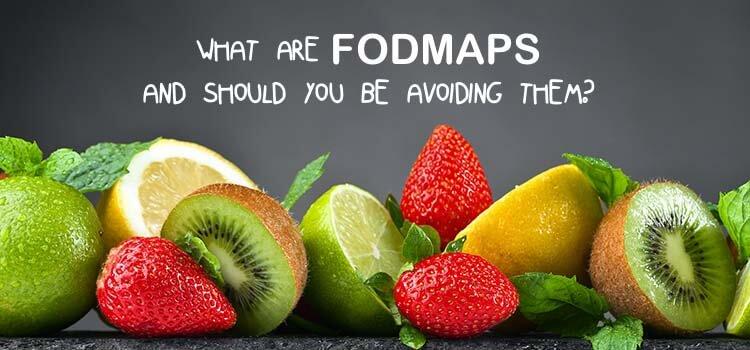
What are FODMAPs And Should You Be Avoiding Them?
More people have digestive issues than you may think. In fact, approximately 40 percent of people have at least one digestive symptom at any time. The most common of these include abdominal pain, constipation, diarrhea, and indigestion. The culprit behind many of these digestive disorders? Lifestyle choices, including the foods you eat.
Enter FODMAPs.
FODMAPs are short-chain carbohydrates that can wreak havoc on digestion in some people. This article explores:
- what FODMAPs are,
- high and low FODMAP foods, and
- whether you should avoid FODMAPs as part of your diet.
What are FODMAPs?
FODMAP stands for Fermentable Oligosaccharides, Disaccharides, Monosaccharides, and Polyols. All of these are short-chain carbohydrates that some people cannot fully absorb in the gastrointestinal tract. In plain speak, they’re undigested sugars. And, because they don’t fully absorb, they reach gut bacteria at the far end of the intestine. When this happens, people feel the physical symptoms of indigestion, such as gas, pain, and diarrhea.
The physical symptoms stem from two main issues:
- Hydrogen − gut bacteria using FODMAPs for energy emit hydrogen gas, causing many of the digestive symptoms mentioned above.
- Liquid in the intestine − as FODMAPs travel into the intestine, they bring liquid with them. This is a common cause of diarrhea.
Not all carbohydrates cause problems. In fact, your gut bacteria use most carbohydrates without causing any symptoms. This is because gut bacteria produce methane when processing low FODMAP carbohydrates. Methane doesn’t cause the digestive symptoms referenced above. However, gut bacteria omit hydrogen, which does cause the symptoms, when processing high FODMAP foods.
It’s important to note that not everyone is sensitive to FODMAPs. Those with Irritable Bowel Syndrome are more likely to suffer from symptoms and experience many of the problems detailed above.

Common types of FODMAPs
The scientific names for each of the FODMAPs don’t mean much to most people. However, some of the most common types of FODMAPs include:
- Fructose − fructose is the simple sugar found in most fruits and vegetables. Fructose can also be an added sugar, commonly in the form of high fructose corn syrup.
- Lactose − lactose is common in dairy products like milk.
- Fructans − fructans are common in glutenous grains like wheat, spelt, rye, and barley.
- Galactans − galactans are common in legumes and other beans.
- Polyols − polyols are sugar alcohols like xylitol, sorbitol, and maltitol. Polyols are found naturally in some fruits and vegetables but are more commonly added as a sweetener.
Read: 5 Healthy Foods a nutritionist wouldn’t touch >>
High and low FODMAP foods
Understanding where foods fall on the high to low FODMAP scale is important. After all, this is the only way you can properly avoid foods that might be triggering indigestion. It’s important that you reference this list because it’s difficult to predict where most foods fall on the scale.

Here are just some of the many examples of high FODMAP foods:
- garlic
- onions
- black beans
- cauliflower
- mushrooms
- apples
- avocados
- pears
- pineapples
- processed meats
- agave
- fruit juices
- sports drinks
- soda containing high fructose corn syrup
- cheese
- milk
- ice cream
This is just a small taste of the many foods you should either avoid or reduce if you find your diet is causing digestive upset. In contrast, here are some of the low FODMAP foods you should focus on when you want to promote digestive health:
- carrots

- broccoli
- cucumber
- kale
- lentils
- lettuce
- pumpkin
- potatoes/sweet potatoes
- bananas
- kiwis
- lemons
- strawberries
- beef
- chicken
- lamb
- pork
- fresh fish and seafood
- most nuts
- seeds
- most condiments
Check out the full list to evaluate what you may want or need to cut back on here…

So should you avoid FODMAPs?
If you experience regular digestive upset, a low FODMAP diet may be something you want to explore. However, the diet itself isn’t foolproof. It’s important to approach the diet with some of the most common mistakes in mind.
- Seek medical advice − if you experience gas, bloating, or other digestive issues, it’s always best to visit your doctor before self-diagnosing and prescribing a solution. If you a re diagnosed with IBS and want to explore the possibility of a low FODMAP diet, it’s always best to do so with a professional dietician or nutritionist.
- Be realistic − eliminating some of the high FODMAP foods won’t necessarily solve your digestive issues. It’s important to experiment with different options to determine which foods are most problematic and to adjust your long-term diet plan accordingly.
- Changing everything at once − it will be impossible to determine which foods are causing digestive upset if you eliminate everything off the high FODMAP list at once. It’s important to make small incremental changes and observe how your body feels after each. Doing so will make it clear which foods you must eliminate and which you may leave in your diet.
- Being too restrictive − even if you must eliminate most or all of the high FODMAP foods, it’s important that you aren’t restrictive about which low FODMAP foods you consume. Eat a variety to stay satisfied and nourish your body.
- Pay attention to fiber intake − many high fiber foods are on the high FODMAP list. As such, those who eliminate most of these foods may take a hit with their diets as well. Be sure to vary your intake of high fiber, low FODMAP foods to avoid suffering any nutritional deficiencies after making the switch.
How will you approach your low FODMAP diet?
If you’ve been diagnosed with IBS or experience gas after your meals more frequently than you would like, a low FODMAP diet is a solution worth exploring. By making incremental changes to examine which foods your body responds to best, you can ensure you’re doing your part to maintain good nutrition while enjoying food without feeling restricted.
Put plainly: there’s no reason to avoid high FODMAP foods if your body digests them well. But if you’ve been struggling, it’s time you made a change and began avoiding some foods you may have once enjoyed. Your comfort, digestion, and well-being are well worth the sacrifice.





